Key Producers Bordeaux
Welcome to the essence of Bordeaux, a region where centuries of winemaking tradition meet the artistry of producing some of the world’s most revered wines. On this page, we introduce you to the key producers who have defined Bordeaux’s global reputation. These iconic estates are more than just names—they are custodians of history, innovation, and excellence. Each producer has a unique story to tell, from generations of family dedication to groundbreaking techniques that have elevated their wines to legendary status. Whether it’s the meticulous attention to detail in the vineyards or the unwavering commitment to quality in the cellar, these producers embody the spirit of Bordeaux. Join us as we celebrate the visionaries behind the wines that have captivated connoisseurs for centuries, and discover the passion that makes Bordeaux a true benchmark in the world of fine wine.
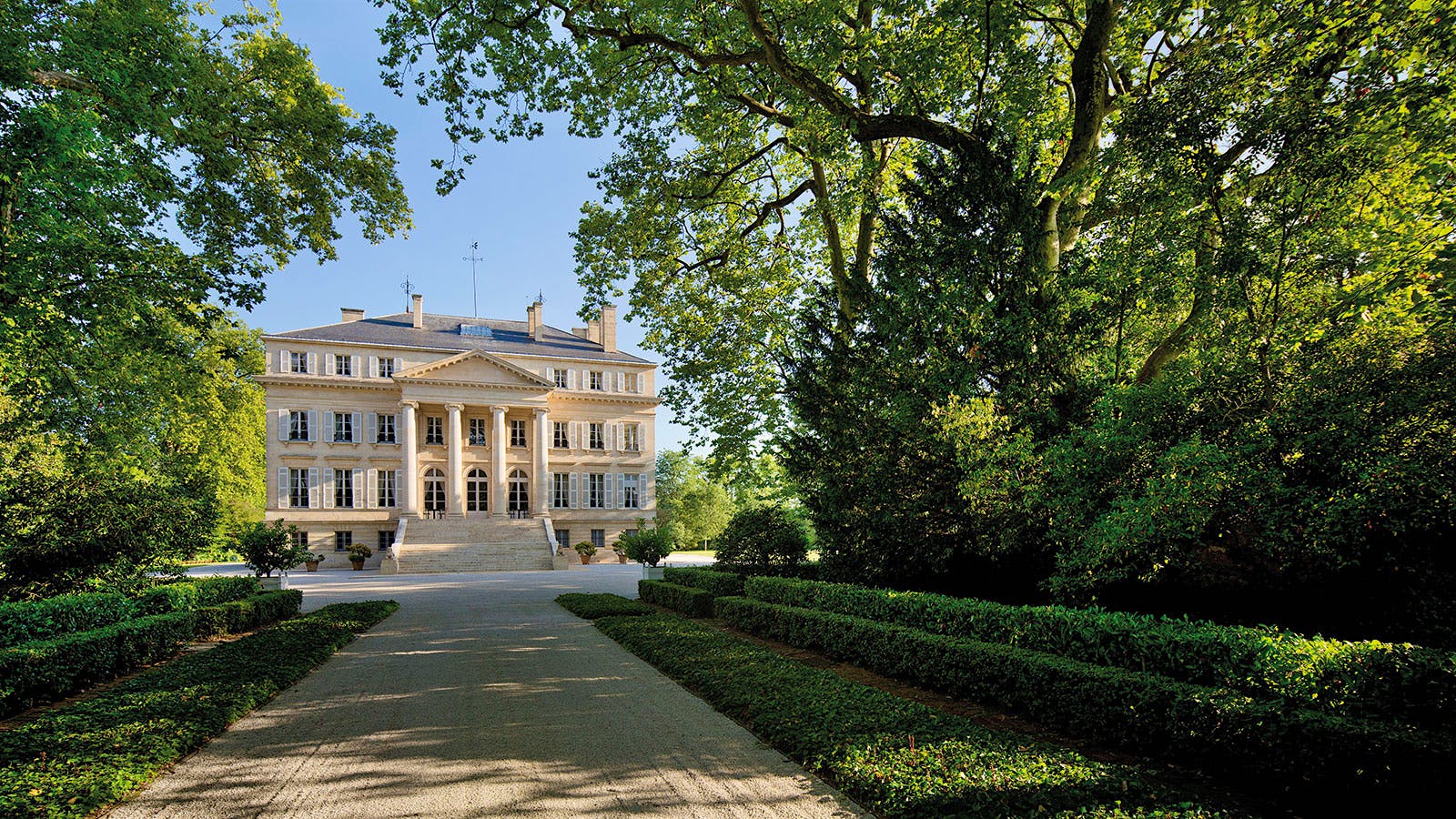
-
Location: Margaux appellation, Médoc, Left Bank
-
Founded: 12th century (gained prominence in the 16th century)
-
Production: 12,000 to 15,000 cases annually
-
Classification: Premier Grand Cru Classé (1855 Classification)
Château Margaux
Nestled in the Margaux appellation of the Médoc region, Château Margaux is one of Bordeaux’s most iconic estates. Founded in the 12th century, it gained prominence in the 16th century under the Lestonnac family and has since become synonymous with elegance and finesse. The estate spans 262 hectares, with 92 hectares dedicated to vineyards, primarily planted with Cabernet Sauvignon. Château Margaux produces approximately 12,000 to 15,000 cases annually, including its grand vin and second wine, Pavillon Rouge. Classified as a Premier Grand Cru Classé in the 1855 Bordeaux Classification, it is celebrated for its ethereal aromas, silky texture, and remarkable aging potential.
Château Margaux’s neoclassical château, designed in the 19th century, is as breathtaking as its wines. The estate has been owned by the Mentzelopoulos family since 1977, who have preserved its legacy while modernizing its winemaking techniques. Known for its meticulous vineyard management and hand-harvesting, Château Margaux consistently produces wines that are a harmonious blend of power and grace. Its grand vin is a benchmark for the Margaux appellation, offering notes of violet, blackcurrant, and spice, with a finish that lingers like a whispered secret.
Château Margaux
Nestled in the Margaux appellation of the Médoc region, Château Margaux is one of Bordeaux’s most iconic estates. Founded in the 12th century, it gained prominence in the 16th century under the Lestonnac family and has since become synonymous with elegance and finesse. The estate spans 262 hectares, with 92 hectares dedicated to vineyards, primarily planted with Cabernet Sauvignon. Château Margaux produces approximately 12,000 to 15,000 cases annually, including its grand vin and second wine, Pavillon Rouge. Classified as a Premier Grand Cru Classé in the 1855 Bordeaux Classification, it is celebrated for its ethereal aromas, silky texture, and remarkable aging potential.
Château Margaux’s neoclassical château, designed in the 19th century, is as breathtaking as its wines. The estate has been owned by the Mentzelopoulos family since 1977, who have preserved its legacy while modernizing its winemaking techniques. Known for its meticulous vineyard management and hand-harvesting, Château Margaux consistently produces wines that are a harmonious blend of power and grace. Its grand vin is a benchmark for the Margaux appellation, offering notes of violet, blackcurrant, and spice, with a finish that lingers like a whispered secret.

-
Location: Margaux appellation, Médoc, Left Bank
-
Founded: 12th century (gained prominence in the 16th century)
-
Production: 12,000 to 15,000 cases annually
-
Classification: Premier Grand Cru Classé (1855 Classification)
Château Lafite Rothschild
Located in the Pauillac appellation of the Médoc, Château Lafite Rothschild is one of the most prestigious wine estates in the world. Its history dates back to the 14th century, but it gained international acclaim in the 17th century when it became a favorite of King Louis XV. The estate covers 112 hectares of vineyards, predominantly planted with Cabernet Sauvignon, and produces around 15,000 to 20,000 cases annually, including its grand vin and second wine, Carruades de Lafite. As a Premier Grand Cru Classé in the 1855 Classification, Lafite is renowned for its finesse, complexity, and ability to age for decades.
The Rothschild family, who acquired the estate in 1868, have maintained its reputation for excellence through generations. Lafite’s wines are celebrated for their signature aromas of cedar, graphite, and black fruits, a hallmark of Pauillac’s terroir. The estate’s meticulous approach to winemaking, from hand-harvesting to extended aging in French oak barrels, ensures that each vintage reflects the purity and elegance of its origins. Lafite’s global prestige is unmatched, making it a symbol of luxury and refinement in the world of fine wine.
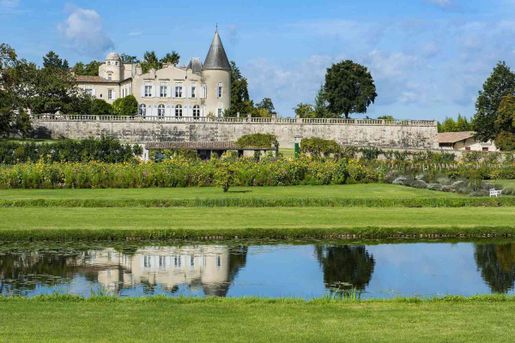
-
Location: Pauillac appellation, Médoc, Left Bank
-
Founded: 14th century (gained acclaim in the 17th century)
-
Production: 15,000 to 20,000 cases annually
-
Classification: Premier Grand Cru Classé (1855 Classification)
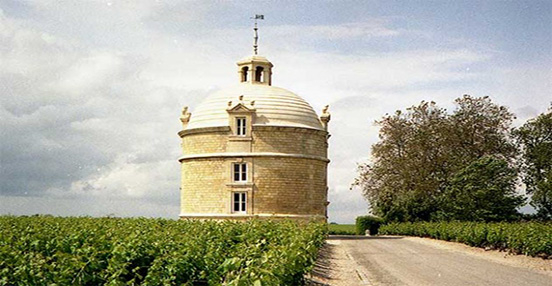
-
Location: Pauillac appellation, Médoc, Left Bank
-
Founded: 14th century
-
Production: 10,000 to 12,000 cases annually
-
Classification: Premier Grand Cru Classé (1855 Classification)
Château Latour
Situated in the Pauillac appellation, Château Latour is one of Bordeaux’s most storied estates, with a history dating back to the 14th century. The estate’s iconic tower, built in the 1620s, inspired its name and remains a symbol of its enduring legacy. Latour’s vineyards cover 92 hectares, primarily planted with Cabernet Sauvignon, and the estate produces approximately 10,000 to 12,000 cases annually, including its grand vin and second wine, Les Forts de Latour. As a Premier Grand Cru Classé in the 1855 Classification, Latour is celebrated for its power, depth, and longevity.
Château Latour has been owned by the Pinault family since 1993, who have invested heavily in modernizing the estate while respecting its traditions. The estate’s unique terroir, with its gravelly soils and proximity to the Gironde estuary, contributes to the wine’s distinctive character. Latour’s grand vin is known for its intense concentration, structured tannins, and complex aromas of blackcurrant, tobacco, and earth. A wine of profound depth and precision, Latour is a testament to the timeless allure of Pauillac’s finest.
Château Latour
Situated in the Pauillac appellation, Château Latour is one of Bordeaux’s most storied estates, with a history dating back to the 14th century. The estate’s iconic tower, built in the 1620s, inspired its name and remains a symbol of its enduring legacy. Latour’s vineyards cover 92 hectares, primarily planted with Cabernet Sauvignon, and the estate produces approximately 10,000 to 12,000 cases annually, including its grand vin and second wine, Les Forts de Latour. As a Premier Grand Cru Classé in the 1855 Classification, Latour is celebrated for its power, depth, and longevity.
Château Latour has been owned by the Pinault family since 1993, who have invested heavily in modernizing the estate while respecting its traditions. The estate’s unique terroir, with its gravelly soils and proximity to the Gironde estuary, contributes to the wine’s distinctive character. Latour’s grand vin is known for its intense concentration, structured tannins, and complex aromas of blackcurrant, tobacco, and earth. A wine of profound depth and precision, Latour is a testament to the timeless allure of Pauillac’s finest.

-
Location: Pauillac appellation, Médoc, Left Bank
-
Founded: 14th century
-
Production: 10,000 to 12,000 cases annually
-
Classification: Premier Grand Cru Classé (1855 Classification)
Château Haut-Brion
Located in the Pessac-Léognan appellation, just southwest of Bordeaux city, Château Haut-Brion is the only estate outside the Médoc to be included in the 1855 Classification as a Premier Grand Cru Classé. Its history dates back to the 16th century, making it one of the oldest wine-producing estates in Bordeaux. The estate spans 51 hectares of vineyards, planted primarily with Merlot and Cabernet Sauvignon, and produces approximately 10,000 to 12,000 cases annually, including its grand vin and second wine, Le Clarence de Haut-Brion.
Owned by the Dillon family since 1935, Haut-Brion is renowned for its innovative spirit and exceptional terroir. The estate’s gravelly soils and unique microclimate contribute to the wine’s distinctive character, marked by aromas of smoke, earth, and dark fruits. Haut-Brion’s grand vin is celebrated for its elegance, complexity, and ability to age gracefully. A pioneer in many aspects of winemaking, Haut-Brion was one of the first estates to use stainless steel tanks and remains a benchmark for quality and innovation in Bordeaux.
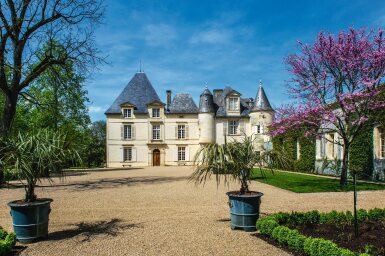
-
Location: Pessac-Léognan appellation, Graves, Left Bank
-
Founded: 16th century
-
Production: 10,000 to 12,000 cases annually
-
Classification: Premier Grand Cru Classé (1855 Classification)
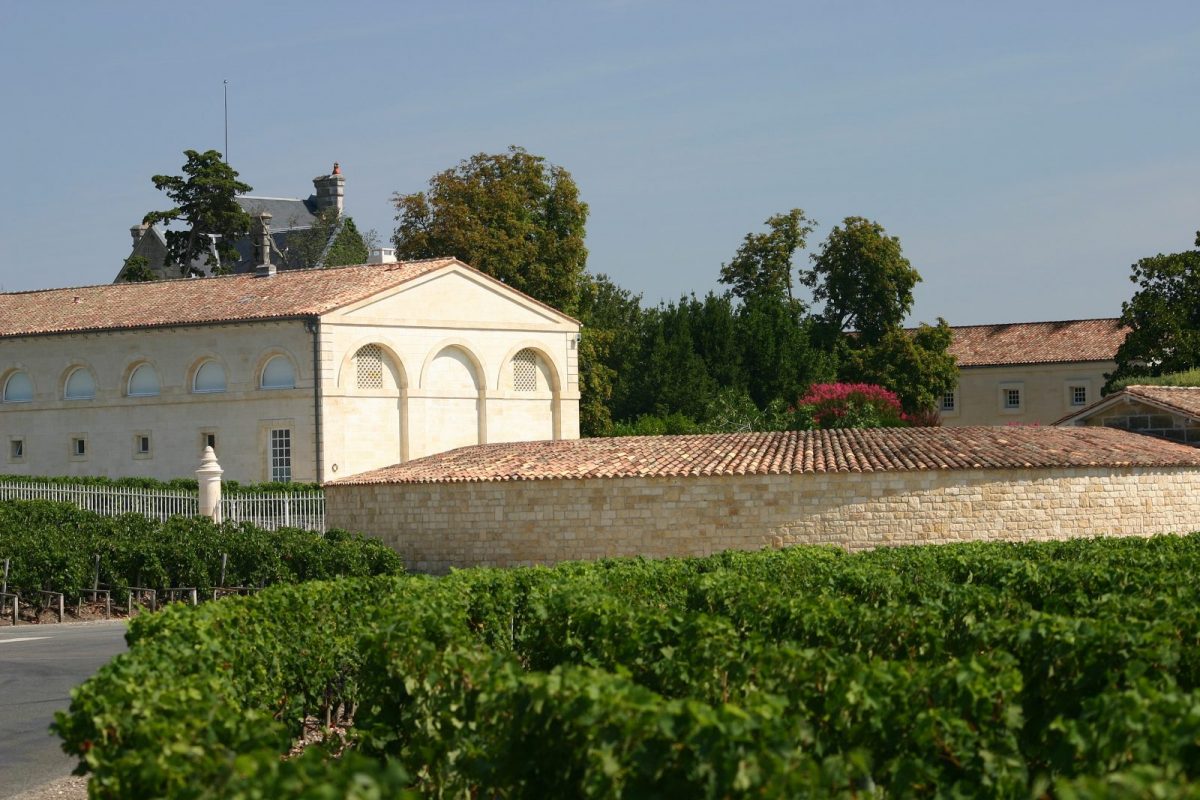
-
Location: Pauillac appellation, Médoc, Left Bank
-
Founded: 18th century (acquired by Rothschild family in 1853)
-
Production: 15,000 to 20,000 cases annually
-
Classification: Premier Grand Cru Classé (elevated in 1973, originally Second Growth in 1855 Classification)
Château Mouton Rothschild
Perched in the Pauillac appellation, Château Mouton Rothschild is one of Bordeaux’s most iconic estates, known as much for its wine as for its artistic labels. Founded in the 18th century, it gained fame under the Rothschild family, who acquired it in 1853. The estate’s 90 hectares of vineyards are primarily planted with Cabernet Sauvignon, and it produces approximately 15,000 to 20,000 cases annually, including its grand vin and second wine, Le Petit Mouton. Originally classified as a Second Growth in 1855, Mouton was elevated to Premier Grand Cru Classé in 1973, a testament to its exceptional quality.
Mouton Rothschild is celebrated for its bold, opulent style and its commitment to art and culture. Each vintage features a unique label designed by renowned artists, from Picasso to Warhol. The estate’s grand vin is known for its rich, full-bodied character, with notes of blackcurrant, cedar, and spice. Mouton’s innovative spirit and dedication to excellence have made it a symbol of creativity and prestige in the world of fine wine.
Château Mouton Rothschild
Perched in the Pauillac appellation, Château Mouton Rothschild is one of Bordeaux’s most iconic estates, known as much for its wine as for its artistic labels. Founded in the 18th century, it gained fame under the Rothschild family, who acquired it in 1853. The estate’s 90 hectares of vineyards are primarily planted with Cabernet Sauvignon, and it produces approximately 15,000 to 20,000 cases annually, including its grand vin and second wine, Le Petit Mouton. Originally classified as a Second Growth in 1855, Mouton was elevated to Premier Grand Cru Classé in 1973, a testament to its exceptional quality.
Mouton Rothschild is celebrated for its bold, opulent style and its commitment to art and culture. Each vintage features a unique label designed by renowned artists, from Picasso to Warhol. The estate’s grand vin is known for its rich, full-bodied character, with notes of blackcurrant, cedar, and spice. Mouton’s innovative spirit and dedication to excellence have made it a symbol of creativity and prestige in the world of fine wine.

-
Location: Pauillac appellation, Médoc, Left Bank
-
Founded: 18th century (acquired by Rothschild family in 1853)
-
Production: 15,000 to 20,000 cases annually
-
Classification: Premier Grand Cru Classé (elevated in 1973, originally Second Growth in 1855 Classification)
Château Cheval Blanc
Located in the Saint-Émilion appellation on Bordeaux’s Right Bank, Château Cheval Blanc is one of the region’s most celebrated estates. Founded in 1832, it gained fame for its unique terroir, which lies at the intersection of gravel, clay, and sand soils. The estate’s 39 hectares of vineyards are planted predominantly with Merlot and Cabernet Franc, and it produces approximately 6,000 to 8,000 cases annually, including its grand vin and second wine, Le Petit Cheval. Classified as a Premier Grand Cru Classé A in the Saint-Émilion Classification, Cheval Blanc is renowned for its elegance, complexity, and aging potential.
Cheval Blanc’s wines are celebrated for their silky texture, aromatic complexity, and ability to express the nuances of its terroir. The estate has been owned by the LVMH group and Bernard Arnault since 1998, who have preserved its legacy while investing in state-of-the-art facilities. Cheval Blanc’s grand vin is a harmonious blend of power and finesse, offering notes of red berries, violets, and spices. A true gem of Saint-Émilion, Cheval Blanc continues to captivate wine lovers with its timeless elegance.
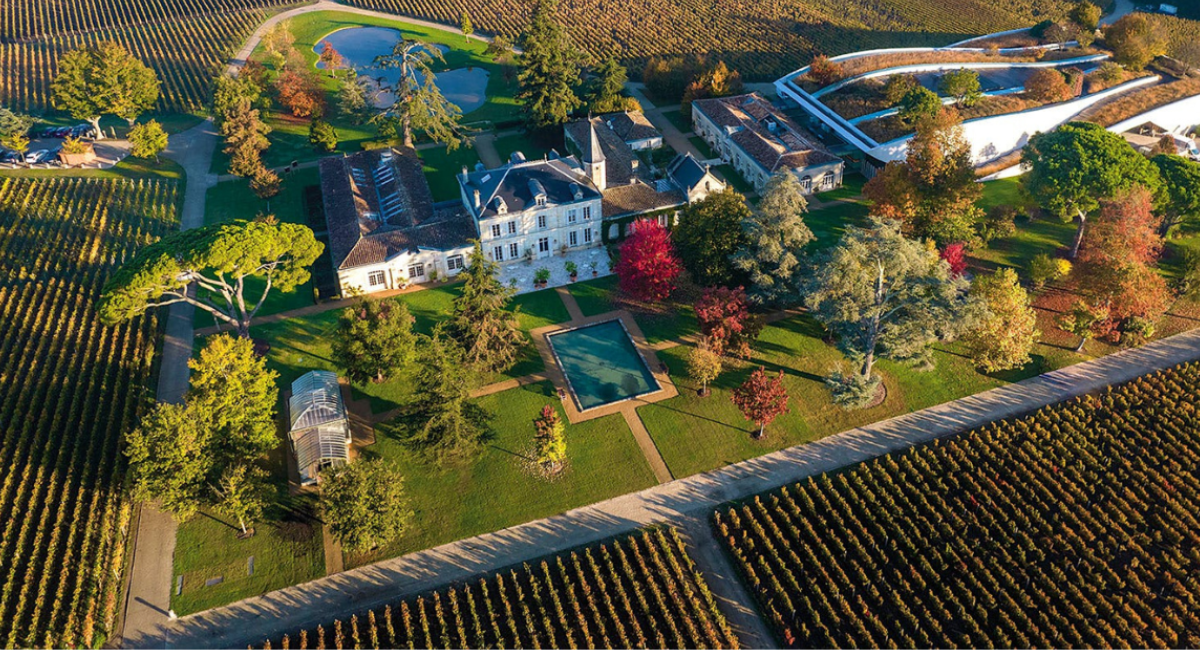
-
Location: Saint-Émilion appellation, Right Bank
-
Founded: 1832
-
Production: 6,000 to 8,000 cases annually
-
Classification: Premier Grand Cru Classé A (Saint-Émilion Classification)

-
Location: Saint-Émilion appellation, Right Bank
-
Founded: Ancient Roman times (named after the poet Ausonius)
-
Production: 1,500 to 2,000 cases annually
-
Classification: Premier Grand Cru Classé A (Saint-Émilion Classification)
Château Ausone
Perched on the limestone slopes of Saint-Émilion, Château Ausone is one of Bordeaux’s most storied estates. Its history dates back to Roman times, and it is named after the poet Ausonius, who is said to have owned vineyards in the area. The estate’s 7 hectares of vineyards are planted primarily with Merlot and Cabernet Franc, and it produces approximately 1,500 to 2,000 cases annually, making it one of the smallest and most exclusive estates in Bordeaux. Classified as a Premier Grand Cru Classé A in the Saint-Émilion Classification, Ausone is celebrated for its rarity, complexity, and aging potential.
Ausone’s wines are known for their purity, precision, and minerality, a reflection of its unique limestone terroir. The estate has been owned by the Vauthier family since the 1990s, who have maintained its tradition of excellence while embracing modern winemaking techniques. Ausone’s grand vin is a wine of extraordinary depth and finesse, offering notes of dark fruits, truffle, and earth. A true expression of Saint-Émilion’s terroir, Ausone is a wine that transcends time.
Château Ausone
Perched on the limestone slopes of Saint-Émilion, Château Ausone is one of Bordeaux’s most storied estates. Its history dates back to Roman times, and it is named after the poet Ausonius, who is said to have owned vineyards in the area. The estate’s 7 hectares of vineyards are planted primarily with Merlot and Cabernet Franc, and it produces approximately 1,500 to 2,000 cases annually, making it one of the smallest and most exclusive estates in Bordeaux. Classified as a Premier Grand Cru Classé A in the Saint-Émilion Classification, Ausone is celebrated for its rarity, complexity, and aging potential.
Ausone’s wines are known for their purity, precision, and minerality, a reflection of its unique limestone terroir. The estate has been owned by the Vauthier family since the 1990s, who have maintained its tradition of excellence while embracing modern winemaking techniques. Ausone’s grand vin is a wine of extraordinary depth and finesse, offering notes of dark fruits, truffle, and earth. A true expression of Saint-Émilion’s terroir, Ausone is a wine that transcends time.

-
Location: Saint-Émilion appellation, Right Bank
-
Founded: Ancient Roman times (named after the poet Ausonius)
-
Production: 1,500 to 2,000 cases annually
-
Classification: Premier Grand Cru Classé A (Saint-Émilion Classification)
Château Pétrus
Located in the Pomerol appellation on Bordeaux’s Right Bank, Château Pétrus is one of the world’s most sought-after wines. Unlike the Médoc estates, Pétrus has no official classification, but its reputation speaks for itself. The estate’s 11.4 hectares of vineyards are planted almost exclusively with Merlot, and it produces approximately 2,500 to 3,000 cases annually. Pétrus is celebrated for its opulence, richness, and ability to age gracefully, making it a favorite among collectors and connoisseurs.
Pétrus’s unique terroir, with its iron-rich clay soils, contributes to the wine’s distinctive character. The estate has been owned by the Moueix family since the 1960s, who have maintained its tradition of excellence through meticulous vineyard management and winemaking. Pétrus’s grand vin is known for its velvety texture, intense aromas of black truffle, plum, and chocolate, and a finish that lingers endlessly. A wine of unparalleled luxury, Pétrus is the crown jewel of Pomerol and a symbol of Bordeaux’s finest.
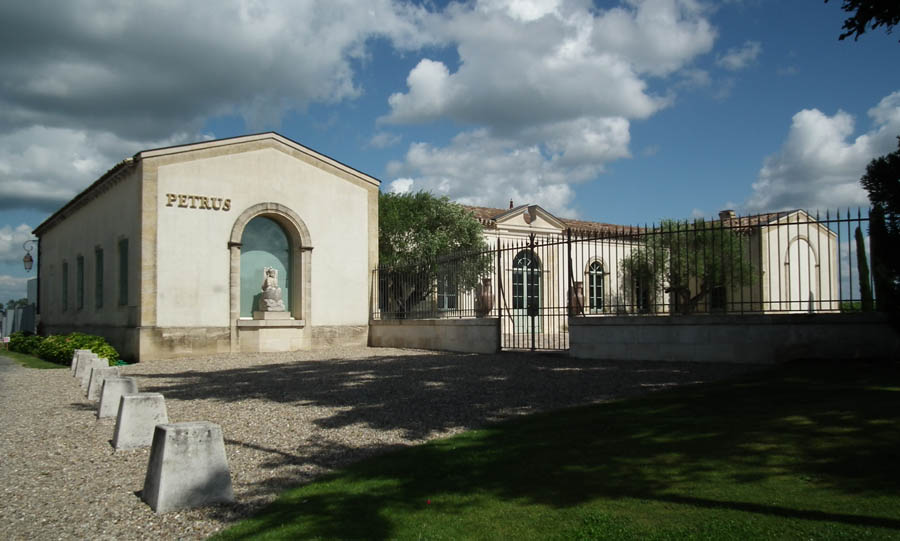
-
Location: Pomerol appellation, Right Bank
-
Founded: 18th century (gained prominence in the 20th century)
-
Production: 2,500 to 3,000 cases annually
-
Classification: No official classification (Pomerol has no classification system)
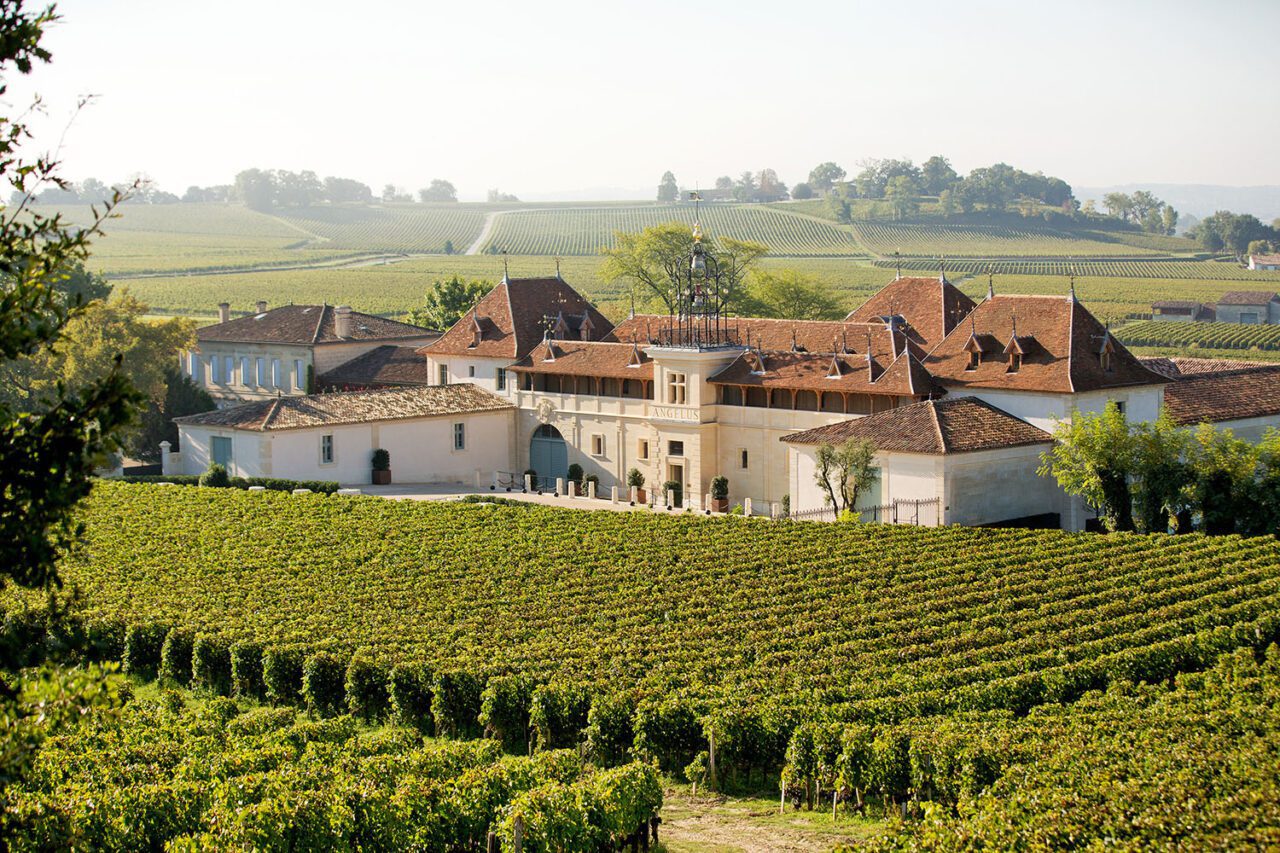
-
Location: Saint-Émilion, Bordeaux, France
-
Founded: 18th century (modern rise under Hubert de Boüard de Laforest in the 1980s)
-
Production: Approximately 10,000 to 12,000 cases annually
-
Classification: Premier Grand Cru Classé A (Saint-Émilion Grand Cru)
Château Angélus
Château Angélus, located in the heart of the Saint-Émilion appellation in Bordeaux, is one of the most iconic and sought-after producers in the region. The estate’s history dates back to the early 18th century, but it was under the leadership of Hubert de Boüard de Laforest in the 1980s that Angélus began its rise to global prominence. Known for its meticulous approach to both viticulture and winemaking, Château Angélus is a symbol of modern Bordeaux excellence. In 1996, the estate was elevated to Premier Grand Cru Classé A, the highest classification in Saint-Émilion, cementing its place among the best of Bordeaux.
Château Angélus produces approximately 10,000 to 12,000 cases annually, with a blend primarily of Merlot and Cabernet Franc. The wine is aged in oak barrels for around 18 months, allowing it to develop its complex, layered flavors. Classified as Premier Grand Cru Classé A under the Saint-Émilion Grand Cru classification, Château Angélus is known for its opulent, rich style, balanced by freshness and finesse. The estate’s wines have become some of the most highly sought-after Bordeaux bottles worldwide, with each vintage praised for its depth, precision, and aging potential.
Château Angélus
Château Angélus, located in the heart of the Saint-Émilion appellation in Bordeaux, is one of the most iconic and sought-after producers in the region. The estate’s history dates back to the early 18th century, but it was under the leadership of Hubert de Boüard de Laforest in the 1980s that Angélus began its rise to global prominence. Known for its meticulous approach to both viticulture and winemaking, Château Angélus is a symbol of modern Bordeaux excellence. In 1996, the estate was elevated to Premier Grand Cru Classé A, the highest classification in Saint-Émilion, cementing its place among the best of Bordeaux.
Château Angélus produces approximately 10,000 to 12,000 cases annually, with a blend primarily of Merlot and Cabernet Franc. The wine is aged in oak barrels for around 18 months, allowing it to develop its complex, layered flavors. Classified as Premier Grand Cru Classé A under the Saint-Émilion Grand Cru classification, Château Angélus is known for its opulent, rich style, balanced by freshness and finesse. The estate’s wines have become some of the most highly sought-after Bordeaux bottles worldwide, with each vintage praised for its depth, precision, and aging potential.

-
Location: Saint-Émilion, Bordeaux, France
-
Founded: 18th century (modern rise under Hubert de Boüard de Laforest in the 1980s)
-
Production: Approximately 10,000 to 12,000 cases annually
-
Classification: Premier Grand Cru Classé A (Saint-Émilion Grand Cru)
Château Cos d’Estournel
Château Cos d’Estournel, located in the Médoc region of Bordeaux, is one of the most renowned estates in the Saint-Estèphe appellation. Its history dates back to 1811 when it was founded by the visionary Louis-Barthelemy Cossin, who was determined to produce wines that could rival the finest Bordeaux. The estate’s name, “Cos,” refers to the hilltop on which the vineyard is planted, and “Estournel” is derived from the nearby village. Cos d’Estournel was classified as a 2nd Growth in the 1855 Bordeaux Classification, but its exceptional quality has often led critics to regard it as one of the top estates in Bordeaux. The château is known for its ornate, exotic architecture, including a pagoda-style tower, reflecting the estate’s commitment to producing wines that stand out both in style and quality.
Château Cos d’Estournel produces approximately 20,000 to 25,000 cases annually, primarily from a blend of Cabernet Sauvignon, Merlot, and a small percentage of Petit Verdot. The wine undergoes fermentation in stainless steel vats, followed by aging in French oak barrels for around 18 months. Classified as a 2nd Growth (Deuxième Cru Classé) in the 1855 Classification, Cos d’Estournel is celebrated for its richness, complexity, and ability to age gracefully. The wines are known for their opulence, intense fruit character, and fine tannins, which have earned them a place among the most sought-after Bordeaux wines in the world.
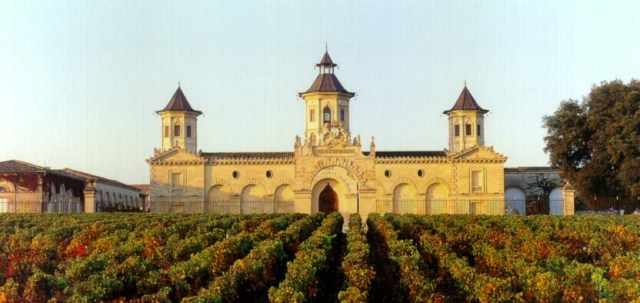
-
Location: Saint-Estèphe, Médoc, Bordeaux, France
-
Founded: 1811 (by Louis-Barthelemy Cossin)
-
Production: Approximately 20,000 to 25,000 cases annually
-
Classification: 2nd Growth (Deuxième Cru Classé) – 1855 Bordeaux Classification
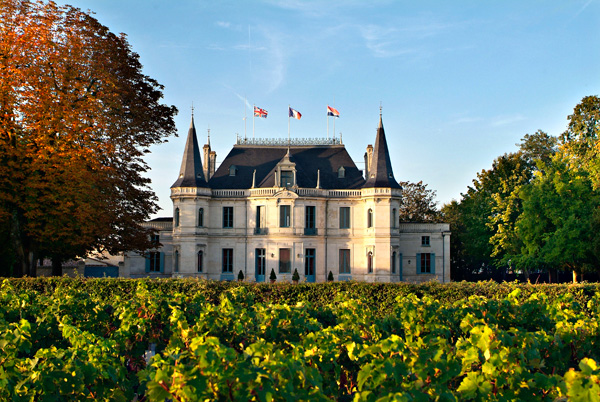
-
Location: Margaux, Médoc, Bordeaux, France
-
Founded: 18th century (rose to prominence in the 19th century under the Comte de Malet Roquefort)
-
Production: Approximately 15,000 to 20,000 cases annually
-
Classification: Third Growth (Troisième Cru Classé) – 1855 Bordeaux Classification
Château Palmer
Château Palmer, located in the Margaux appellation of Bordeaux, is renowned for producing some of the finest wines in the Médoc region. The estate’s history dates back to the 18th century, but it was in the 19th century when it rose to prominence under the ownership of the Comte de Malet Roquefort. The château was classified as a Third Growth (Troisième Cru Classé) in the 1855 Bordeaux Classification, and despite its ranking, the estate is consistently considered among the very best in Bordeaux. Château Palmer is known for its elegant, balanced wines that exhibit a perfect harmony of fruit, structure, and finesse. The estate’s vineyard is managed with the utmost attention to detail, using organic and sustainable practices to nurture the vines.
Château Palmer produces approximately 15,000 to 20,000 cases annually, primarily using a blend of Cabernet Sauvignon, Merlot, and Petit Verdot. The wine is aged in French oak barrels for about 18 months to develop its signature complexity. Classified as a Third Growth (Troisième Cru Classé) in the 1855 Bordeaux Classification, Château Palmer wines are known for their rich, layered flavors, with a perfect balance of power and elegance. They have earned a reputation for being able to age for decades, evolving in complexity and refinement over time, making them highly sought after by collectors.
Château Palmer
Château Palmer, located in the Margaux appellation of Bordeaux, is renowned for producing some of the finest wines in the Médoc region. The estate’s history dates back to the 18th century, but it was in the 19th century when it rose to prominence under the ownership of the Comte de Malet Roquefort. The château was classified as a Third Growth (Troisième Cru Classé) in the 1855 Bordeaux Classification, and despite its ranking, the estate is consistently considered among the very best in Bordeaux. Château Palmer is known for its elegant, balanced wines that exhibit a perfect harmony of fruit, structure, and finesse. The estate’s vineyard is managed with the utmost attention to detail, using organic and sustainable practices to nurture the vines.
Château Palmer produces approximately 15,000 to 20,000 cases annually, primarily using a blend of Cabernet Sauvignon, Merlot, and Petit Verdot. The wine is aged in French oak barrels for about 18 months to develop its signature complexity. Classified as a Third Growth (Troisième Cru Classé) in the 1855 Bordeaux Classification, Château Palmer wines are known for their rich, layered flavors, with a perfect balance of power and elegance. They have earned a reputation for being able to age for decades, evolving in complexity and refinement over time, making them highly sought after by collectors.

-
Location: Margaux, Médoc, Bordeaux, France
-
Founded: 18th century (rose to prominence in the 19th century under the Comte de Malet Roquefort)
-
Production: Approximately 15,000 to 20,000 cases annually
-
Classification: Third Growth (Troisième Cru Classé) – 1855 Bordeaux Classification


